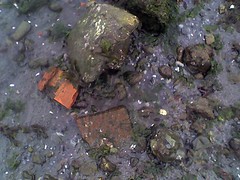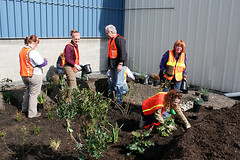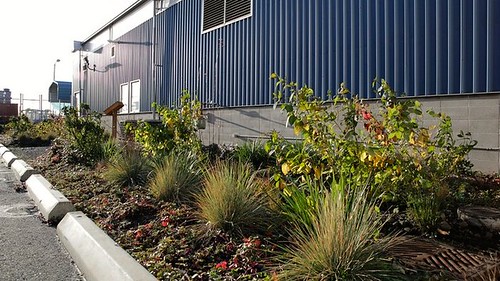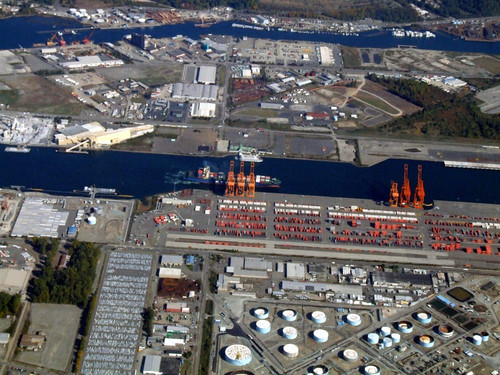How a rain garden cleans industrial pollution

Posted January 25, 2012 at 1:33PM
(Note: Today’s post was conceived and largely authored by my friend and frequent collaborator, Lee Epstein. Lee is an attorney, land use planner, and sustainability advocate working in the mid-Atlantic region.)
As NRDC’s water program rightfully emphasizes, one of the most vexing conundrums in highly urban areas is how to handle polluted rainwater runoff. The way we used to do it, shunting it out of sight into the nearest creek or river, as fast as possible, just won’t do anymore. We now know that untreated stormwater has lots of deleterious effects on the environment. Polluted runoff carries with it a toxic brew of heavy metals and oil compounds from motor vehicles, tons of loose dirt, nitrogen and phosphorus from construction sites and lawns, and everything else you can think of – or would rather not – that forms the detritus of our modern lives.
These pollutants wreak havoc in rivers, lakes and estuaries. Additionally, rooftops, parking lots and streets can get pretty hot on sunny days, so add thermal pollution to the mix. Finally, hardened urban surfaces don’t allow rain to trickle down through the soil and slowly recharge groundwater and streams; rather, stormwater runs furiously off these “impervious” surfaces, with volumes that erode the sides of streams, adding more sediment to the water column and gouging away any usable natural habitat.
Yet we also need urban density to absorb growth and development that would otherwise take the form of suburban sprawl, spreading even more pavement around watersheds.  Density protects watersheds from new sources of runoff at the same time that it can complicate the cleaning up of existing polluted waterways.
Density protects watersheds from new sources of runoff at the same time that it can complicate the cleaning up of existing polluted waterways.
Just as part of redeveloping cities and towns in a sustainable way must involve integrating pleasant, useable green space and nature into urban environments, another part of the equation must be creating more appropriate means to handle polluted rainwater. Fortunately, there’s been a good deal of work done over the past decade along these lines. This blog has featured much of this thinking, particularly with regard to “green infrastructure” and how it can serve multiple functions.
One of the most challenging things about dealing with stormwater in a city, however, is the fact that a city is, by definition, already largely urban. So bringing it back to a condition where its remaining (or now-buried) waterways are part of a living, functioning system isn’t easy or cheap. As redevelopment proceeds, more green can be required, such as green roofs, or plantings in parking areas and along streets that double as a means to infiltrate and clean stormwater. But sometimes, the green “kick in the pants” can come from some other demand or some other opportunity.
Seattle – like many a coastal or riverfront town -- is a major port city, and many of its edges are highly industrialized with port-serving facilities. One wouldn’t think to go to one of these rough-and-tumble sites to see a “rain garden.” (Rain gardens are one of the green practices used by stormwater managers to treat and infiltrate runoff. They’re basically depressions dug into the ground whose layers of soil mimic more natural areas, where water filters slowly through the ground, and where plants “take up” nutrients and trace elements that might otherwise become pollutants.)
But a recent article by Seattle Public Television’s KCTS 9 multimedia reporter, Katie Campbell, explained “how does an industrial rain garden grow?” in just such an unlikely location.
First, the scene described in Campbell’s story: Commencement Bay, Port of Tacoma. Very industrial setting. Lots of pavement, warehouses, container ship operations and… containers -- acres of containers. This is a major cargo shipping port. Totem Ocean Trailer Express (TOTE), a shipping company that hauls cargo between Tacoma and Alaska, couldn’t meet some of the tight pollutant discharge requirements in its Washington State industrial stormwater permit. With all that galvanized metal (from shipping containers and the metal sides of buildings), it’s pretty logical that there might be something not so good running off the parking areas, into the storm drains, and straight into the Bay. In this case, that something turned out to be zinc, which can be extremely hazardous to marine life. The pollution wasn’t easily visible; reportedly, the storm drain regularly emptied clear water into the Bay. But it was insidious, a silent toxin.
The customary response might have been to hire an engineering firm to develop an industrial-type solution, a mechanical filtering system or an expensive settlement and treatment basin. Instead, TOTE engaged David Hymel of Rain Dog Designs to design and supervise installation of a rain garden – for about $24,000, a fraction of the cost of an industrial-engineering solution. Pavement was dug up and removed along a thin strip of land, into which was mixed compost and mulch, and then some 600 plants and shrubs were planted. Runoff was directed into this rain garden.  As a result, stormwater discharges directly into the water were reduced substantially and the discharge limits are now being met.
As a result, stormwater discharges directly into the water were reduced substantially and the discharge limits are now being met.
We asked Hymel about the water quality results: could the pollution be entering the waterway via infiltration rather than directly? While this is a possibility (and sometimes a problem in urban places where there are legacy polluted soils beneath the pavement), it is unlikely here, he said. Zinc largely binds up in the upper crust of compost and mulch, he reported and, I expect, some plants might even take up trace amounts as a nutrient.
So, are rain gardens a solution to every urban stormwater runoff problem in every place? Of course not, but as was shown here, a little ingenuity can go a long way to resolving some of these types of problems with non-traditional solutions – solutions that introduce some green among the urban gray infrastructure and that mimic nature, if they cannot replace it. In cities, rain gardens and other bioinfiltration techniques can often be installed in the sidewalk-to-curb strip along streets and in large planters in urban settings. Rainwater can also be harvested and recycled for beneficial uses – in chiller towers, fire suppression systems, and for watering and fountain features.
Stormwater runoff is an issue of increasing environmental importance. Greening our urban areas is often an issue of increasing economic and social importance. Some cities, such as Philadelphia and Lancaster, Pennsylvania, are beginning to come up with solutions that resolve both problems. So are places like a heavy industrial site in Tacoma, Washington, where a little green has now sprung up in a very unlikely place.
David Hymel and TOTE are featured in this nicely informative video about the installation of TOTE’s rain garden:
Please also visit NRDC’s Sustainable Communities Video Channel.

